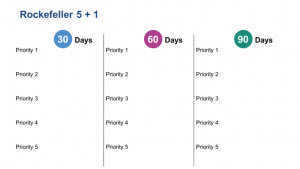7 Making It Stick: The Rockefeller 5 + 1 Approach
Making It Stick: The Rockefeller 5 + 1 Approach
The Rockefeller 5+ 1, developed from the Rockefeller strategy tool kit (Harnish, 2010)[1] is a ‘rapid’ decision tool and a useful approach to use to be able to establish the importance and relevance of an initiative within a portfolio of initiatives and opportunities. The basic premise of the tool that any leader, manager or project lead, can and should only have five core priorities, that link with the five core priorities of the division or organisation as a whole.
If this process is followed throughout the organisation, then the most senior leaders in the organisation would set the five core priorities, and then ensure that each and every team, and every team member, is working on their own core priorities, that can be explicitly linked to one or more of the organisation’s objectives! The idea then is that at any given time, all behaviours and actions are linked to, and measured by, their impact on those ‘top five’.
One additional piece, the ‘+1’, is the idea that in fact at any given moment, those delivering on outcomes, should be completely focused on the ‘#1 priority’ at that moment!
Another component of the ‘getting things done’ action set is the addition of the Watkin’s 30:60:90 principles (Watkins, 2013)[2], adapted here for this purpose. The basic principle of the tool is that the first 90 days of a project can be mapped out, as a planning horizon, on large, visible and prominent display.
Within the first 30 days, the project should be scoped, team members on boarded and actioned, measures specified and all structures and needed resources in place. By the next 30 days, at the 60-day mark, there should be significant progress made on the initiative, and a retrospective and reflection exercise undertaken, with adjustment steps as necessary.
At the 90-day mark, the project should be measured against the key measures that were specified, and the team should have a strong and robust conversation about progress and outcomes. At this stage too, the project overall should be evaluated. Stop, Modify, or Proceed decisions, should be taken.
Each 30-day stage should be an open, shared and transparent gathering, and the 90 Day Mark should be an explicit event, with key stakeholders and senior leaders present. A ’90 Day Breakfast’ event is a great way to do this.
At times, team leaders will try to reject such short, clear and visible milestones, with the comment that their project is much longer-term, more complex, or involves far too many stakeholders to be useful. The simple fact is that a year comprises four times 90-day periods; two years is eight times 90-day periods, etc. Any project no matter how complex has key high-level priorities and timelines, and core essential stakeholders.
By combining the ‘5+1’ and’30:60:90’, many of those objections can be overcome, and success can be explicit and celebrated. By adding the ‘5+1’, the teams can stay focused on those top ‘5’ and be explicitly working on the ‘#1’.
Here is a short video that shares tips and hints.
The following figure shows a possible approach to this combined tool.

Figure 1: The 30:60:90 Day Rockefeller ‘5 + 1’ Adapted from (Watkins, 2013 and Harnish, 2010)[3]
[1] Harnish, V. (2010). Mastering the Rockefeller Habits: What You Must Do to Increase the Value of Your Growing Firm. . Gazelles Inc.
[2] Watkins, M. D. (2013). The First 90 Days: Proven Strategies for Getting UP to Speed Faster and Smarter. Harvard Business School Press.
[3] Harnish, V. (2010). Mastering the Rockefeller Habits: What You Must Do to Increase the Value of Your Growing Firm. . Gazelles Inc.
Watkins, M. D. (2013). The First 90 Days: Proven Strategies for Getting UP to Speed Faster and Smarter. Harvard Business School Press.
__________________________________________________
